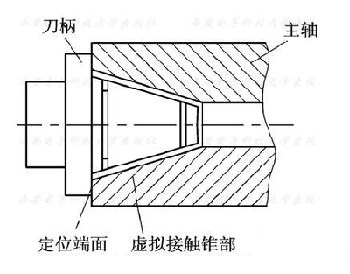High-speed tool system structure and principle introduction (3)
2) hot chuck The hot chuck is also a chuck without clamping elements. It usually uses the high-energy field induction heating coil to heat the clamping part of the shank in a short time (10s), and the inner diameter of the shank expands. At this time, the tool is immediately loaded into the shank, when the shank cools and contracts. This gives the tool a uniform pressure on the clamping surface, resulting in a high radial clamping force that holds the tool firmly. When the cutting tool is loaded or removed, the collet cools rapidly, so heat is rarely transferred to other parts of the collet or to the handle of the tool. In addition to this, there are some tool chucks for high-speed machining, such as collet chucks, hydraulic chucks, balancing chucks and TRIBOS chucks. 3. Tool holder structure The traditional shank structure can not meet the needs of high-speed machining, mainly unable to meet the requirements of connection rigidity, precision, dynamic balance and rapid tool change. At present, there are two ideas to solve the problem of high-speed machining of the shank structure: First, the existing 7:24 taper is used to improve its structure, such as the WSU shank produced in the United States; on the other hand, the original 7 is discarded: 24 taper and new alternatives such as HSK holders and KM holders. ? The WSU shank takes advantage of the concept of virtual taper, which forms a tapered surface with discrete points or lines that are in contact with the inner tapered surface of the spindle, as shown in Figure 2. The elements that make these point line contacts are elastic. Therefore, when the axial force of the pull rod causes the shank to be in contact with the end surface of the main shaft, only the elastic members of the shank cone are deformed, and the shank is not deformed. This method allows the contact cone to obtain a large interference without requiring too much tension and does not cause the spindle to expand, which is insensitive to contamination of the contact surface. For example, the WSU-1 holder requires the same machining accuracy as a conventional shank. The taper of the shank still uses a 7:24 taper, but its diameter is smaller than the diameter of the standard shank taper of the same flange size. The outer surface is covered with a ball of the same diameter fixed by a metal or plastic cage. The diameter of the virtual cone formed by the ball is about 5~10 μm larger than the diameter of the taper hole in the main shaft. Under the pulling force of the rod, the ball is elastically deformed, and the handle is Move in the spindle taper until the shank flange contacts the end face of the spindle. The material of the ball is metal, plastic or glass. The manufacturing precision is very high. The precision of the spherical surface and the manufacturing precision of the diameter are all below 1μm. The strict manufacturing precision can ensure the good cooperation between the virtual cone and the spindle taper. Previous Next Solar Street Light,Solar Street Lamp Post,Solar Powered Street Lamp Post,Solar Powered Parking Lot Lights Zhongshan Tiger Lighting Co.,Ltd. , https://www.tigerstreetlight.com
Figure 2 WSU holder structure and connection to the spindle